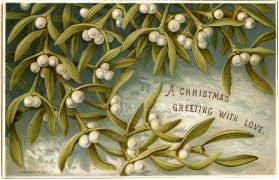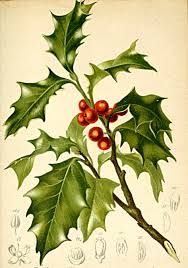Mistletoe (Viscum): A parasitic plant that grows on many of the apple trees in the museum’s orchard
The Word ‘mistletoe’ comes from the (old English mistiltan). It may come from the German word Mist which means dung and Tang for branch, since mistletoe can be spread from the droppings of birds as the move from tree to tree.
In pre-Christian societies across Europe, mistletoe was seen as a representation of divine male essence and thus a symbol of fertility and vitality. The mistletoe used today in celebrations is thought to be the same type used by the ancient druids in their sacred rituals. Indeed they held the plant Viscum album to be holy.
With the arrival of Christianity this pagan belief like so many others was incorporated in to new religion. The earliest documented case of kissing under the mistletoe during the Christmas season dates from the 16th century in England, a custom that was very popular at the time. According to an old Christmas custom a man and a woman who meet under a hanging of mistletoe were obliged to kiss. The custom may be of Scandinavian origin.
Holly (Ilex aquifolium): A prickly evergreen associated with Christmas.
European Holly (Gaelic: cuileann) was sacred to the druids who associated it with the winter solstice and wore wreaths of it on their heads. For the Romans, holly was considered the plant of Saturn (Jupiter) king of their gods. European Holly has always been traditionally had a strong association with Christmas. In heraldry holly is meant to symbolize truth. Henry VIII wrote a love song “Green growth the holly” which alludes to holly and ivy resisting winter blasts and not changing their hue “So I am and ever hath been unto my lady true”….or so he said?
In the extremely popular and best-selling Harry Potter novels, holly is used as the wood in the titular character’s wand.
Between the 13th and 18th centuries before the introduction of turnips holly was cultivated for use as winter fodder for cattle and sheep. The less spiny varieties of holly were preferred, and in practice the leaves growing near the top of the tree have far fewer spines making them more suitable for fodder.
Holly wreaths are often part of the Christmas traditions, as is the popular carol The Holly and the Ivy.
Chestnut tree (Castanea sativa): the provider of chestnuts a traditional Christmas food.
The roasting of chestnuts goes back centuries, when people turned up the heat on these nuts for more than just festive fare. Chestnuts became a staple in the mountainous regions around the Mediterranean Sea thousands of years ago, in part because most cereal grains couldn’t grow in these areas. These flavourful nuts are low in fat, high in fibre and full of vitamins and minerals. Evidence of its cultivation by man is found since around 2000 B.C. Alexander the Great and the Romans planted chestnut trees across Europe whilst on various campaigns. The Greek army is said to have survived their retreat from Asia Minor in 401-399 B.C. thanks to their store of chestnuts. Dioscorides and Galen, wrote of chestnuts to comment on their medicinal properties – and of the flatulence induced by eating too many of them.
Roasting sweetens the nut’s raw, bitter flavour, which could also help explain its history of being eaten around Christmas when celebrations usually involve eating sweet things.
There doesn’t seem to be any consensus on when and where people began the tradition. Early Christians believed the nut symbolized chastity, which, although that theme does not tie in directly to Christmas, does to religion. Some historians say that roasting chestnuts dates back to the 16th century, when vendors sold them on the streets of Rome. Other scholars put their debut in Portugal for St. Martin’s Day, and in Modena, Italy for St. Simon’s Day.
Scott Tampin, Heritage Gardening Trainee



















